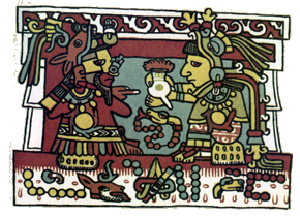
"Since Pre-Columbian Mixtec documents are mainly concerned with histories, they record historical events such as royal births, wars and battles, royal marriages, forging of alliances, pilgrimages, and death of rulers. In addition to the calendrical signs used for dating events and naming individuals, the Mixtecs used a combination of conventionalized pictures as well as glyphs to illustrate the type and nature of the event. An example is … the wedding scene, usually shown as as two individuals of opposite sex facing each other and sitting on jaguar-pelt chairs, as illustrated by this example from the Codex Nuttall recording the marriage of the legendary Mixtec king 8 Deer "Tiger Claw" of Tilantongo to Lady 12 Snake on the day 13 Snake of the year 13 Reed (1051 CE)."
"This arrangement of the bride and groom is a purely pictorial convention, with no connection to the language. This means that no idiom or phrase in the Mixtec language describing two people sitting facing each other is a metaphor for marriage. However, the cup of chocolate held by Lady 13 Snake may represent the expression ynodzehua, which means "dowry" in Mixtec, where the root dzehua means "chocolate". Chocolate or cacao was one of the most expensive and luxurious products in Mesoamerica, and cacao beans were used as currency. It is no surprise the word for dowry would be based on chocolate." -- ancientscripts.com/mixtec
